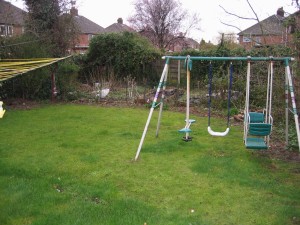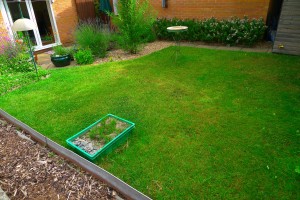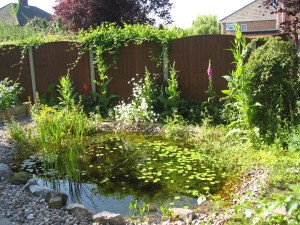Do you enjoy mowing your lawn?
Yes I know we have lost around 97% of our flower-rich meadows and in the whole scheme of things, my tiny lawn will not make much difference to that loss. However, it makes a significant difference to me, the interest and pure pleasure I derive from it. I know it makes a huge difference to the wildlife with which I share the garden. If we all did this, even on a very small scale it would make a difference and I feel sure you would get more pleasure and interest from your miniature wildflower meadow than you would from mowing your lawn!! Plus you may only have to mow it once a year!! How great is that?
Ever thought of a miniature wildflower area?
Having been brought up near Liverpool city centre, trees, flowers, meadows, gardens even lawns were not seen. The terraced houses had backyards, outside toilets and no gardens. All of my schools, even my grand grammar school, had tarmac playgrounds, with not a blade of grass or tree in sight! I had never seen a wildflower meadow, only on TV. I decided from an early age that I wanted my own wildflower meadow. I did create a beautiful annual cornfield area about 8 ft x 4 ft many years ago when I moved to a house with a garden. By mulching the area with carpet to kill the lawn, from spring till autumn depriving the grass of light killed it and its roots.
Sowing the cornfield annual seeds
Early autumn, after removing the carpet (non-foam backed), I removed 2-3″ topsoil and raked the soil to expose any weed/grass seeds, which soon germinated. After a fortnight I replaced the carpet which killed those seedlings, leaving it on for a fortnight or so. Then I removed the carpet and scattered my cornfield wildflower seeds mixed with sand (to see where I had sown) and gently raked them in. A few touches of frost and a little snow seemed to help germination and come late spring they really started to grow. By summer it was stunning, so much so several that local conservation groups came to view it along with my wildlife garden. Year 2 corn cockle and ox-eye daisies took over and year 3 grass had started to really grow and to spread from 3 edges and taking over again.
The back of the garden was fenced off with a large spaced wire fence, allowing wildlife to freely pass through. It had a small pond, raised organic beds, compost heaps, trees, shrubs, ivy, blackberry, etc. Scores of wild bird species visited the garden including kestrels and sparrowhawks catching prey.
I planted wildflower plugs into the lawn on a few occasions but they get swamped by the rye grass in the lawn. Pot grown fair a little better being bigger and having a stronger root system. I came to the conclusion that seed sowing and wildflower plugs/pots in a rye grass garden lawn, used by young children and a dog as their play area was not a very successful way to have a wildflower lawn! Completely killing the lawn, worked the best along with removing the top soil. Making a wildlife garden piece meal like this took some time and I had some great successes and failures. The experiences helped me to write my successful book, “Gardening for wildlife” available rather nicely priced on the internet nowadays as it is out of print!
Moving house to a smaller garden allowed me to finally rid myself of the dreaded lawn mower!
Not having a pond in my new garden but finding newts and frogs in the spring through to autumn and missing my old much larger wildlife pond, above, I decided to create a small pond in keeping with the small garden. A video coming soon!
Small wildflower areas in lawn
In my new garden, you will see a few more small lawn areas planted up, with pot grown wildflowers rather successfully but time consuming having to wait a full growing season to kill the lawn by mulching. No bits and pieces any more! This time I took drastic action to create a miniature wildflower meadow and a new pond.
Not forgetting the hedgehogs!
Near the end of the film you get a glimpse of my very successful hedgehog hole made in the recycled plastic gravel board I used to replace the usual concrete slab type. These should be made to accommodate wildlife!! Other holes are behind the shed and garage for frogs, hedgehogs, etc.
See Part 2 film from lawn to a wildflower meadow
The miniature wildflower meadow has been filmed over the year and will feature it at various stages as it changes, matures and grows. A list of the flowers will come in another article and video. The new larger meadow will not be a cornfield meadow, as it has mainly perennials growing in it. I was somewhat amazed at the new insect species it brought into the garden as it grew and flowered. It was made for the insect life. If you want to become involved in pollinating insect research join the Buzz Club
With thanks to my family who partially funded it as a special birthday present for me, when you reach a milestone age!!





Inspiring! If only everyone did this, our cities would be teeming with wildlife 🙂 Go George!
Thanks Dave, Yeah! Just imagine a patchwork of mini meadows..throughout our towns and cities! How wonderful, colourful and interesting people would find it! Wildlife too! Cheers, George
Well done George. Looks amazing just like an established cottage garden. Have the fence panels got access opening for hedgehogs from garden to garden??
Look forward to seeing next spring/summer results.
Marian
Thanks! Wait till you see the wildflowers, grasses etc. Absolutely with hedgehog fence panel….I think it is in the video just posted! Cheers, G
I love people share their experience with others and help them to have an excellent deal. You did a great job, specially the video is so helpful.
Thank you for sharing with us, love this.
My pleasure Sean Cheers George